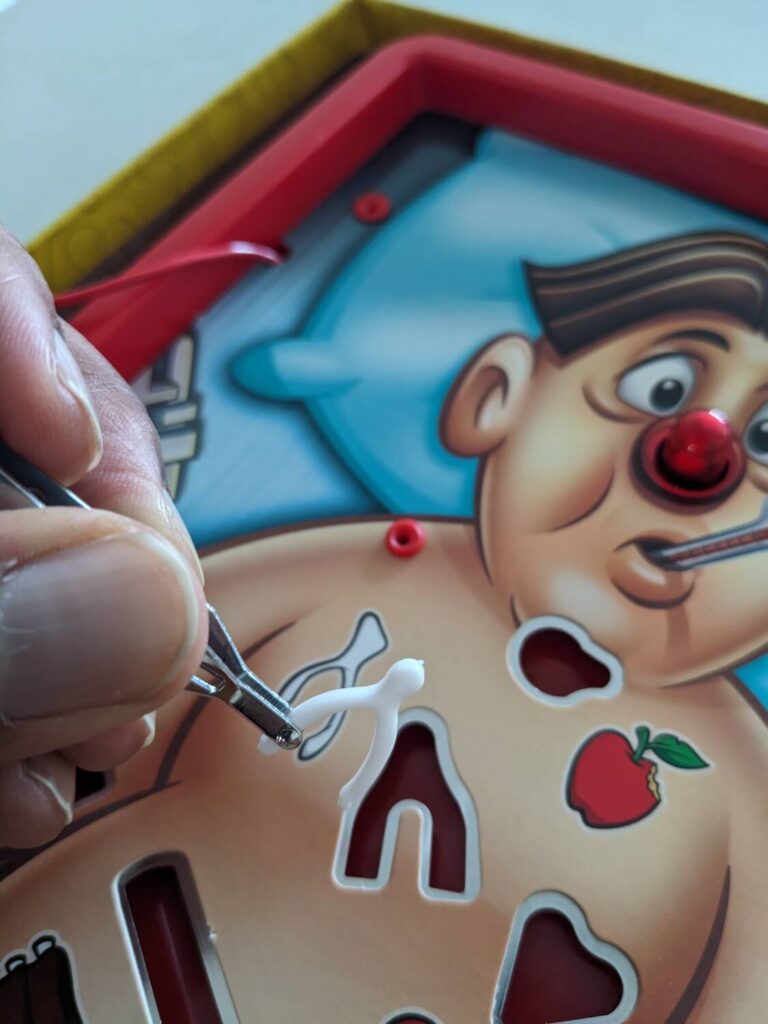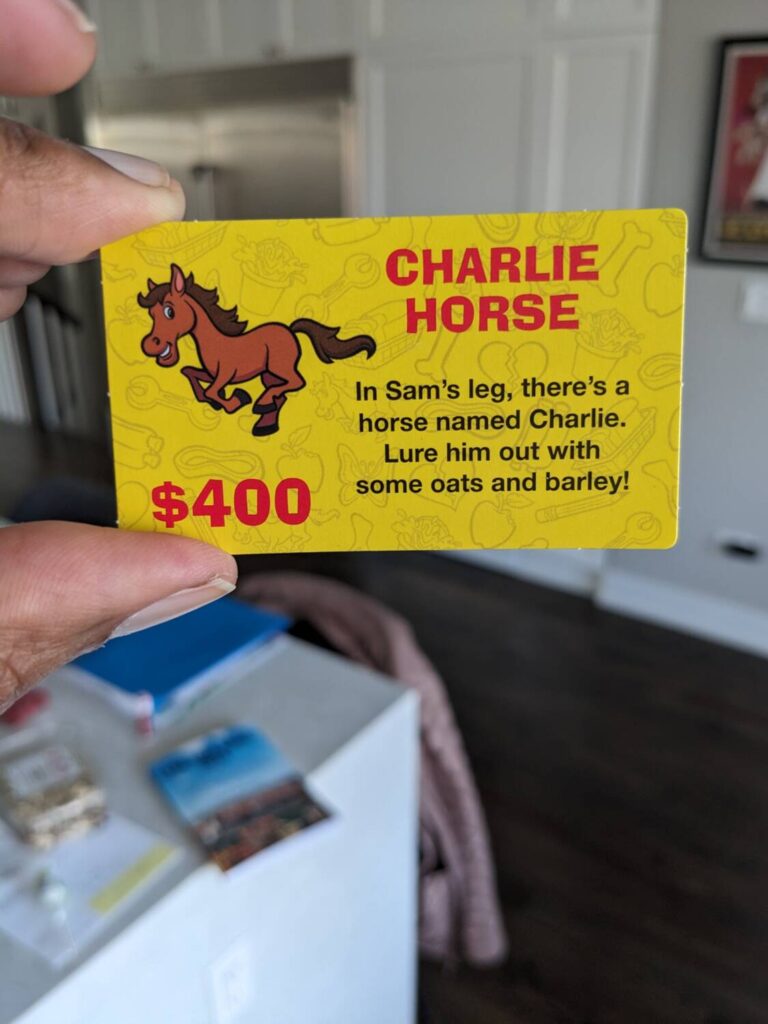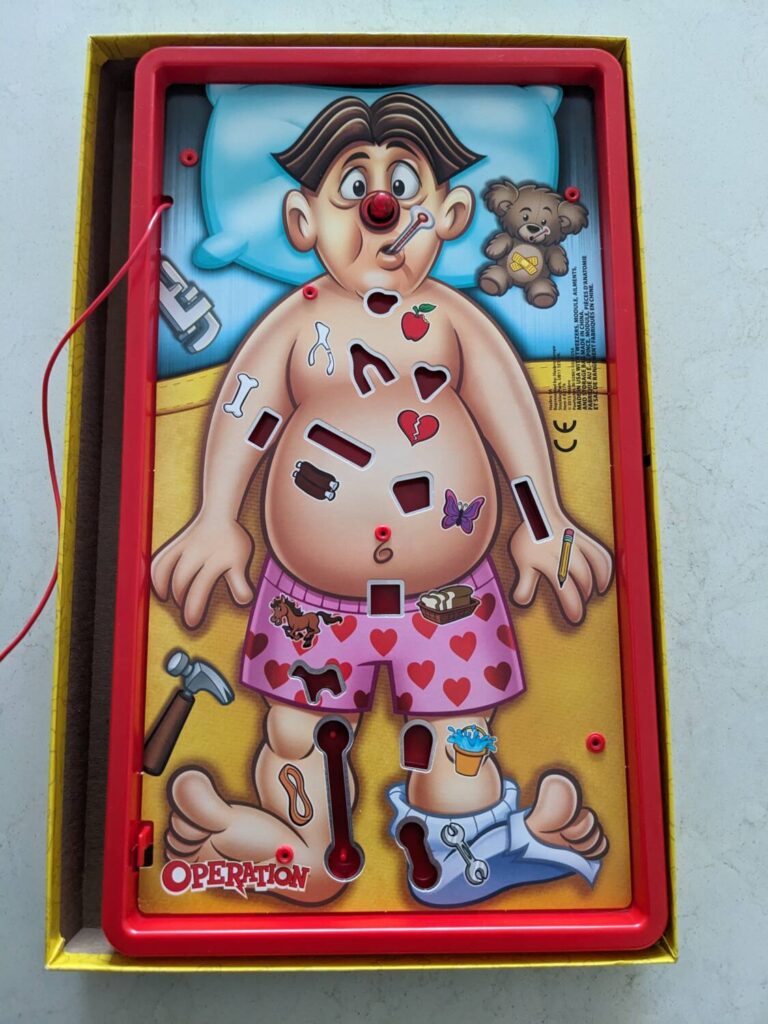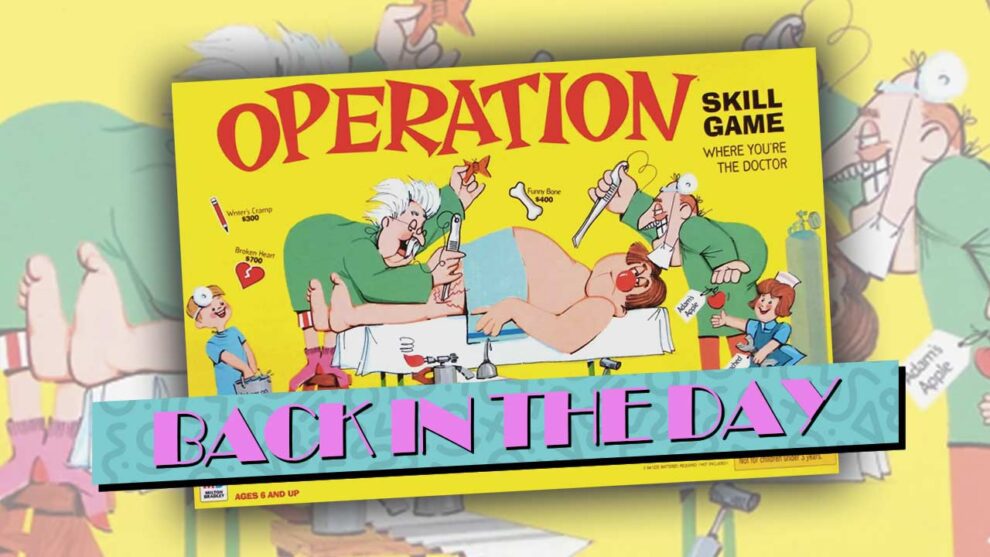Buried deep—and I mean, DEEP—in the Bell family gaming closet lies a copy of Operation, first released back in 1965.
It stays in our collection in part because the kids never ask to play it. But as a part of our Back in the Day game series, I wanted to pull out some of the games we haven’t touched in a while to see if they still entertain us like the good ol’ days. (That, and I’m running low on review copies. Publishers: wink, wink.)
Operation is maybe the oldest dexterity game I own, with Jenga (published in 1983) the next closest. Operation, for the uninitiated, is that game that has a board that features the body of a patient on an operating table.
Cavity Sam is the name of the patient who looks a little alarmed because he’s got about a dozen open spots on his nearly naked body, with weird items like a full piece of bread, a horse, an apple, a pencil (!!!), and a wrench along with more standard-issue problems like a wishbone and a rib that need to be removed in order to save his life.
As surgeons tasked with getting everything out of the guy, the game is simple. A player draws a card to determine which item they must remove on their turn. Using tweezers to carefully pull each item out of Sam’s body, players will earn a certain amount of cash for each item removed. If a player touches the metal sides of the space where each item comes out, the entire board buzzes and Sam’s nose lights up, reminding players that you blew it and play moves to the next player.
In our Back in the Day articles revisiting classic experiences, we normally don’t do a deep dive into the game’s rules…but the paragraph above summarizes all the rules for Operation. Let’s focus on what still works, and what doesn’t, while making a recommendation on whether you need to dig this one out of your attic or not! (For links to the other articles in this series, please check out the links at the end of the article.)

Operation: What Still Works?
Here’s the first thing that surprisingly still works: the batteries in my copy of the game, which before these recent review plays definitely hadn’t been played in since at least the start of the COVID era, maybe four years ago. That allowed Operation to get to the table real quick-like because I didn’t need two fresh AA batteries!
The game is so easy to teach and play, and the same tricks still work: grabbing the smallest part of the item (or areas like the crack in the piece of bread) to pull the item out of Cavity Sam is always the way to go. And there is no way to cheat—if Sam’s nose turns red, you failed your turn, and the little buzz that sends shivers up the arm of the active player still make me laugh whenever our family (usually my son and I) play the game.
The simple draw deck, which dictates the item currently in need of operation and the amount of money a player gets if they successfully remove an item, makes turns a snap, and if all players fail to remove an item in succession, that card just moves to the bottom of the deck. (We house rule that and just throw the card out of the game, to shorten the overall play time.)
Games of Operation are fast. I can play it solo in less than 10 minutes, and other players don’t add much time since there are no additional items to remove from the body. And for anyone who has a steady hand, Operation is always a fun, quick test amongst friends…and that’s before you add any alcohol.

Operation: What Doesn’t Work?
Here’s the part that shocked all my family members during a recent play: the game is easier than I remembered when playing it as a kid.
The cavity spaces are not any bigger, or at least they don’t feel significantly different. (All games released nowadays are easier than they were when I was a child, so it wouldn’t shock me if some of the spaces were a little wider and the items were a tad smaller.) What this means, sadly, is that I recently played solo and pulled all 12 items out of Cavity Sam without coming close to skipping my turn. My son—who admittedly does have steady hands and never seems to drop anything due to fumbling around—can also get close now to doing a perfect run of the game.
Also, a minor issue for me: it doesn’t quite feel like the amount of money scored for each item matches with the difficulty required to get specific pieces out of there. In the oldest version of the game, the slice of bread was the most valuable piece in the game at $1,000. But I always felt that the apple (“Adam’s Apple”) was harder to grab because the item is smaller and its round shape makes it tricky to keep in the tweezers. The apple only nets $100 for the player.
Is the slice of bread ten times harder to remove? Uh, no. The horse only nets $200, but its opening is a little trickier to navigate than other items. It just feels like the scale is off a bit, which of course becomes a problem if a player can draw two or three of the most valuable items and successfully get them out. Operation is one of those old games that has nothing resembling a catch-up mechanic.

Yea or Nay?
Nay.
Dexterity games have come a long way since Operation, and even a game like Jenga regularly hits our family game table a lot more than Operation, for good reason. While it was fun to break this out a few times recently, the game faded from view with my kids almost right away and will likely move out of our collection soon after this article is published.
Operation is a short game and it still jogs the memory of better plays as a child myself. But it was easy to say goodbye to this one. Happy trails, Operation!
The Back in the Day Series:












Add Comment